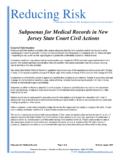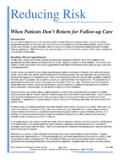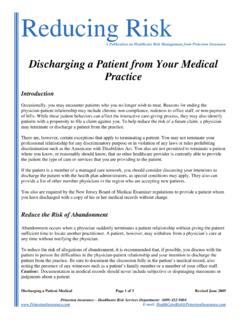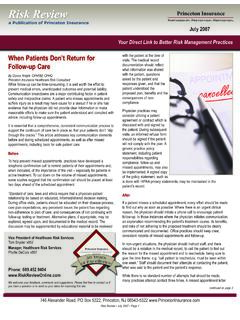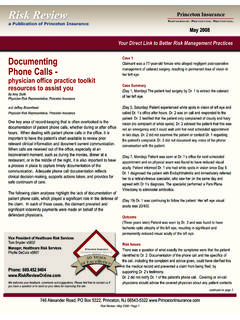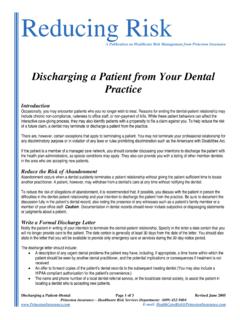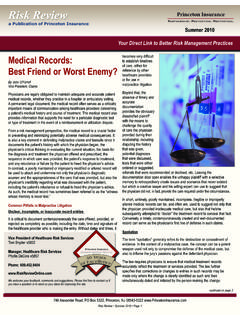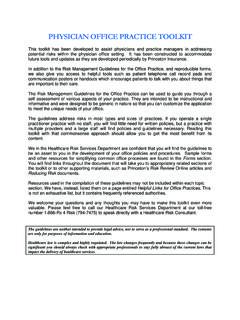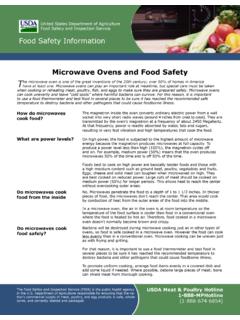Transcription of Reducing Risk - Princeton Insurance
1 Reducing Risk A Publication on HealthCare Risk Management from Princeton Insurance Risk Alert Hot Liquids: Avoiding Patient Injury Burns or scalds attributable to hot beverages pose a serious concern for any organization providing food service to consumers. This concern is particularly worrisome for healthcare facilities treating already physically compromised patients. A well-publicized 1992 incident involved Stella Liebeck, an Albuquerque, NM woman who received burns from a cup of coffee purchased at a McDonald's restaurant. Public perception following the subsequent lawsuit largely held that this multi-million dollar jury award ($160,000 for compensatory damages and $ million for punitive damages) was nothing more than a frivolous claim.
2 Challenging public sentiment was an HBO documentary Hot Coffee (2011) examining the facts surrounding the case with a focus on the mental anguish, physical trauma (3rd degree burns) and two years of treatment (including skin grafting to her thighs and groin area) experienced by the victim following the incident. We believe such incidents in a healthcare setting may attract greater media attention, result in greater personal harm and higher claim settlements, not to mention severely damaging the reputation of the facility and its staff. Even the most well-intentioned, compassionate, patient-focused healthcare giver attempting to satisfy a simple patient request for a heated beverage can become party to an incident that endangers a patient's well-being.
3 Avoiding catastrophe What are the systems failures that turn an act of kindness into crisis? Risk management and patient safety efforts with regard to hot liquids should focus on staff adherence to policies and procedures related to the proper and approved use of facility equipment (such as any device used to heat liquids), appropriate response to patient needs/requests for a hot beverage, and patient monitoring following delivery of a heated beverage. Your facility may be like many others with established operational hours for dietary services. If so, accommodation for those after-hours patient requests for hot beverages needs to be considered to ensure that all staff respond to such requests uniformly, as approved by management.
4 Let's review factors that may contribute to an incident involving a burn or scald from hot liquids. microwave ovens A recent informal poll of acute, assisted living and long-term care facilities found a range of responses to the question: Does your facility allow the use of microwave ovens ? Some facilities do not permit such equipment on nursing floors and in patient care areas. Others permit microwave ovens on patient floors for staff use only. Still others permit the use of microwave ovens on patient floors, but do not restrict their use exclusively to the personal needs of staff (such as heating food during a shift break).
5 It is the last scenario above that harbors the greatest potential for harm to a patient. If the use of microwave ovens is permitted in a facility, understand that each microwave oven is unique in terms of energy used, time needed to heat something to a desired temperature, the age of the equipment, amount of use and so forth. All staff using microwave ovens must appreciate the potential for liquids to exceed boiling points (known as superheating) without any recognizable appearance of a rolling boil. Hot Liquids: Avoiding Patient Injury Page 1 of 3 October 2011. Princeton Insurance HealthCare Risk Management Department: (609) 452-9404.
6 E-mail: Reducing Risk A phenomenon known as nucleation typically occurs when a liquid being heated allows bubbles to form, gas to escape, the boiling to occur, and thus be visible. However, in microwave conditions, nucleation may not occur. If trapped gases cannot escape, a higher probability exists that the liquid being heated will explode when the container is moved or something such as a tea bag, coffee crystals or powdered drinks is added. Factors facilitating nucleation are impurities in the liquid being heated or some type of defect (irregularity) in the surface coating of the container itself.
7 Alternative sources for hot liquids There are alternatives to microwave ovens , some of which may be cost-effective when considering the replacement of ovens with equipment that affords greater safety . Following are choices made by facilities to provide hot beverages without compromising the threshold of safety for patients and staff: Hot water delivered from dietary services stored in thermoses at the nurses' station. Water coolers equipped with a hot water tap that is maintained at an established temperature to avoid burns or scalds. Some type of unit similar to a coffee urn that heats water and keeps it hot at a regulated temperature.
8 Serving hot liquids What about cups to serve the hot liquid beverage? Are the cups or beverage containers supplied to patients contributing to the potential for a spill that may result in patient scalding or burning? Styrofoam cups usually are tapered, where there is greater area at the top of the cup, which slims down in a V formation to a smaller area at the bottom. Such a design harbors the potential for a spill: the cup, when filled with liquid, has more mass and, therefore, more weight at the top, making it somewhat imbalanced and unstable for patients to handle safely. Using a cup design that is uniformly contoured from top to bottom will help decrease the likelihood (risk) of a cup filled with a hot liquid from tipping over.
9 When microwave ovens are a must If using microwave ovens is unavoidable for heating beverages (be that for staff or patient service), users should be knowledgeable of the following: Use only containers suitable for microwaving. Place a non-metallic object in the liquid to be heated (such as a wooden spoon or stirrer). Use a beverage setting to heat the liquid if the microwave oven has such an option. Caution: using such a setting is no guarantee that the liquid will not be overheated. Absent a beverage setting, do not heat the liquid on high. Instead, use a lower power setting for a longer period of time to permit the nucleation process to occur and avoid superheating.
10 Once heated, leave the container in the microwave undisturbed for 1 minute per cup of liquid being heated. Remove the container from the microwave oven slowly (covered, if possible). When serving the heated water with an accompanying tea bag or powdered beverage, if at all possible, stay with the patient until the flavoring agent has been introduced to the liquid to be certain there is no problem with the beverage temperature before patient consumption. Not all microwave ovens are created equal. Even if those microwave ovens used in the facility are of the same make and model, each should be tested individually by qualified technicians to determine the length of time it takes for a given volume of liquid to reach a pre-determined temperature at a specific power (such as 50%).
